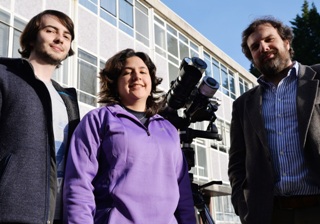Mar 13 2015
Scientists from Aberystwyth University will be heading to the Norwegian archipelago of Svalbard later this week to study the total eclipse of the sun on Friday 20 March.
 Left to right: Postgraduate researchers Joseph Hutton and Nathalia Alzate who will be travelling to Svalbard to study the eclipse, and Dr Huw Morgan, Reader at the Solar System Physics Group at Aberystwyth University.
Left to right: Postgraduate researchers Joseph Hutton and Nathalia Alzate who will be travelling to Svalbard to study the eclipse, and Dr Huw Morgan, Reader at the Solar System Physics Group at Aberystwyth University.
Researchers Joe Hutton and Nathalia Alzate are members of the Solar System Physics Group at the Department of Physics at Aberystwyth University.
On Svalbard they will join an international team of scientists from the USA, the Czech Republic and Germany to study the sun's atmosphere, the corona.
The team, affectionately known as the Solar Wind Sherpas, will use up to 14 specially adapted cameras to photograph the sun at different frequencies during the eclipse to catch images of plasma emitted from the sun's corona.
The plasma is only visible during a total eclipse. The images will be used to calculate the temperature of the corona.
The temperature of the sun is known to be around 6000oC. However the temperature of the corona is around 1,000,000oC, with some areas reaching 2,000,000oC.
Data and images captured during the eclipse will be used to develop mathematical models to try and understand this difference in temperature.
Dr Huw Morgan is a Reader at the Solar System Physics Group at Aberystwyth University. Between 2006 and 2010 Huw travelled to the Sahara Desert, the Gobi Desert (China), the Marshall Islands and Tahiti in the Pacific Ocean to take measurements during total eclipses of the sun. He is overseeing the Aberystwyth work on this latest eclipse.
Dr Morgan said: "The difference between the temperature of the sun and that of the Sun's corona is one of the great mysteries of astronomy. A total eclipse gives us an unique opportunity to measure the corona of the sun is so much detail and collect data that will enable us to better understand this difference."
"Aberystwyth University is part of a world leading group of scientists that is dedicated to studying the sun. Understanding what goes on in the sun's corona is critical to protecting satellite based communication systems which can be severely disrupted by solar storms caused by coronal mass ejections."
The team on Svalbard will be led by Professor Shadia Habbal, Professor of Solar Physics at the University of Hawaii and a former Professor at the Department of Physics at Aberystwyth University.
Based at an old observatory on Svalbard that has been adapted to view this eclipse, the Solar Wind Sherpas will be joined by three Aberystwyth undergraduate students who are currently spending a semester at the University Centre in Svalbard (UNIS) as part of their Planetary and Space Physics degree.
The 2015 eclipse will be 100% over the North Pole and will coincide with the day when the sun comes into view after 6 months of polar night, a phenomenon which is believed to happen once every 400,000 to 500,000 years.
The study is funded by the National Science Foundation and NASA.